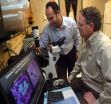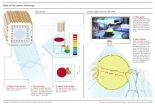(Press-News.org) Two essential genes that control the accumulation and detoxification of arsenic in plant cells have been identified. This discovery is the fruit of an international collaboration involving laboratories in Switzerland, South Korea and the United States, with the participation of members of the National Centre of Competence in Research (NCCR) Plant Survival. The results presented are a promising basis for reducing the accumulation of arsenic in crops from regions in Asia that are polluted by this toxic metalloid, as well as for the cleanup of soils contaminated by heavy metals. The findings are published this week in the prestigious journal PNAS.
The sinking of tubewells in Southeast Asia as well as mining in regions such as China, Thailand, and the United States, are the cause that arsenic concentrations in water often exceed the World Health Organization (WHO) limit of 10 μg/L, the value above which health problems start to occur. Tens of millions of people are exposed to this risk by drinking contaminated water or by ingesting cereal crops cultivated in polluted soils. A long lasting exposure to this highly toxic metalloid could affect the gastrointestinal transit, the kidneys, the liver, the lungs, the skin and increases the risk of cancer. In Bangladesh, it is estimated that 25 million people drink water that contains more than 50 μg/L of arsenic and that two million of them risk of dying from cancer caused by this toxic substance.
Plants offer a way for toxic metals to enter the food chain. We know, for example, that arsenic is stored within rice grains, which, in regions polluted with this toxic metalloid, constitutes a danger for the population whose diet depends to a great extent on this cereal.
Arsenic or cadmium in soils is transported to plant cells and stored in compartments called vacuoles. Within the cell, the translocation of arsenic and its storage in vacuoles is ensured by a category of peptides – the phytochelatins – that bind to the toxic metalloid, and are transported into the vacuole for detoxification, similar to hooking up a trailer to a truck. In terms of the process, it is the "truck and trailer" complex that is stored in the vacuole.
"By identifying the genes responsible for the vacuolar phytochelatin transport and storage, we have found the missing link that the scientific community searched for the past 25 years", explains Enrico Martinoia, a professor in plant physiology at the University of Zurich. The experiments carried out on the model plant Arabidopsis can easily be adapted to other plants such as rice.
Enrico Martinoia is one of the directors of this research that includes the Korean professor Youngsook Lee from the Pohang University of Science and Technology (POSTECH) and Julian Schroeder, biology professor at the University of California, San Diego (UCSD). Along with Stefan Hörtensteiner, also from the University of Zurich, and Doris Rentsch from the University of Bern, he is one of the three members of the NCCR Plant Survival who participated in this study which was published in PNAS.
Controlling these genes will make it possible to develop plants capable of preventing the transfer of toxic metals and metalloids from the roots to the leaves and grains thereby limiting the entry of arsenic into the food chain. "By focusing on these genes, states Youngsook Lee, we could avoid the accumulation of these heavy metals in edible portions of the plant such as grains or fruits."
At the same time, researchers have discovered a way to produce plants capable of accumulating a greater amount of toxic metals which consequently can be used to clean up contaminated soils. These plants would then be burned in blast furnaces in order to eliminate the toxic elements.
INFORMATION:
END
Scientists are learning more about how protein gets in the urine when the kidneys begin to fail and how a new drug blocks it.
"We have known for a long time that renal failure comes with protein in your urine, especially in diabetes," said Dr. David Pollock, renal physiologist at the Medical College of Georgia Vascular Biology Center. It's also known that a new class of drugs called endothelin A receptor antagonists reduce protein in the urine.
New research published in the journal Hypertension connects the two, providing more information about how new drugs under study ...
WASHINGTON — The United States is missing significant opportunities to reduce traffic fatalities and injuries, and could save lives by implementing a more rigorous, comprehensive program that adopts successful safety practices from other countries, says a new report by the National Research Council.
The committee that wrote the report reviewed traffic safety practices and strategies in high-income countries around the world and compared them with those in the United States. From 1995 to 2009, fatalities dropped 52 percent in France, 38 percent in the United Kingdom, ...
INDIANAPOLIS – Failure to have a prescription filled can undermine medical treatment, result in increased health care costs and potentially have devastating results for the patient. An editorial in the Nov. 16 issue of the Annals of Internal Medicine highlights the problem and issues a call to action.
In the editorial, "Prescription Abandonment: Another Path to Medication Nonadherence," Michael D. Murray, PharmD, MPH, a Regenstrief Institute, Inc. investigator and Purdue University professor of pharmacy practice, and Jeff Harrison, Ph.D., of the University of Auckland, ...
Montreal, November 16, 2010 – Disadvantaged kids are more likely to drop out of high school, become premature parents and raise their own children in poverty, according to an exhaustive new study from researchers at Concordia University and the University of Ottawa.
Published in the International Journal of Behavioral Development, the investigation was the first to follow boys and girls over three decades to examine whether childhood aggression, social withdrawal and low socio-economic status could impact adult wellbeing.
"Low socioeconomic status appears to have ...
A new study from the Swedish medical university Karolinska Institutet shows that asthma drugs are a potential treatment for aortic aneurysm. These drugs, which block cysteinyl-leukotrienes, could reduce the break down of vessel wall tissue and the dilation of the aortic wall, and thus the risk of its rupturing. This could both save lives and reduce the need for complicated and risky surgery. The results are presented in the scientific journal PNAS.
Aortic aneurism is a life-threatening disease caused by the weakening of a section of the wall of the aorta, which then ...
HealthSpace, the internet-accessible personal health organiser developed as part of the National Programme for IT in the National Health Service, was significantly less popular than anticipated, a research team from the University of London has found.
Instead of the predicted 5-10% of the population signing up, only 0.13% of those invited got as far as activating the full functionality of their personal health record, according to the study published on bmj.com today.
Professor Trisha Greenhalgh from Barts and the London School of Medicine and Dentistry led the team ...
Researchers from the Group of Applied Artificial Intelligence (GIAA) on the Colmenarejo Campus of UC3M have presented this application at the latest Salón Internacional de Material Eléctrico y Electrónico, recently held in Madrid. The participants at the stand of Infaimon, the company which has collaborated on this project, had the opportunity to test this interface with a videogame operated simply by moving ones hands as if holding a virtual steering wheel. For this purpose, the scientists have employed a time of flight camera or TOF with which they capture in 3D user's ...
An open letter from 20 consultants and a patient group published on bmj.com today, calls on the prime minister to take action over a legal loophole that allows drug companies to make easy profits by licensing existing treatments for rare (orphan) diseases.
They argue that the current situation concerning orphan drugs is not in the best interests of patients or the NHS and that the cost to the NHS is likely to be above £10m a year.
The original purpose of this legislation was to encourage drug companies to conduct research into rare diseases and develop new treatments. ...
The metallic particles in the smoke emitted by fireworks pose a health risk, particularly to people who suffer from asthma. This is the conclusion of a study led by researchers from the Institute of Environmental Assessment and Water Research (IDAEA-CSIC), published this week in the Journal of Hazardous Materials.
"The toxicological research has shown that many of the metallic particles in the smoke from fireworks are bio-reactive and can affect human health", Teresa Moreno, a researcher from the IDAEA (CSIC) and lead author of a study that has been published this week ...
ANN ARBOR, Mich. -- University of Michigan researchers have solved the structure of a protein that is integral to processes responsible for maintaining a healthy heart and nervous system.
The protein structure in question is cystathionine beta-synthase, known as CBS. CBS uses vitamin B6 to make hydrogen sulfide (H2S), a gaseous signaling molecule that helps maintain a healthy heart and nervous system. H2S also induces a state of suspended animation or hibernation in animals by decreasing body temperature and lowering metabolic rate.
The work to decode the structure ...



